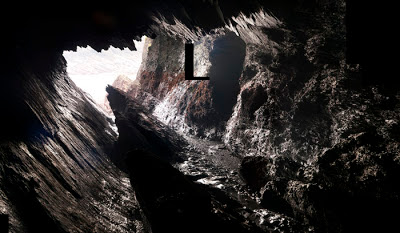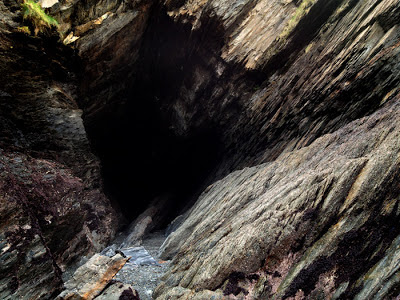The spring tides in February were spent exploring Samson?s Bay, just east of Hele Bay, North Devon. Philip Henry Gosse in A Naturalists Rambles on the Devonshire Coast 1853 described it like this, and I expect it hasn’t changed too much since then as it is rarely visited:
“A little way beyond this point the traveller looks down upon a cove called Sampson’s Bay; it is girt in with rocky cliffs of great massiveness and wild grandeur, too abrupt and perpendicular to be scaled, even by the most expert climber. An ample cavern yawns on the western side of the bay, into whose depths, as the tide was high, the surf was dashing, with a roar that rivalled the discharge of artillery. I thought of the fine simile of Thomas Moore:
‘Beneath, terrific caverns gave
Dark welcome to each stormy wave
That dash’d, like midnight revellers, in’
A new friend, Alan, showed me the old mining track down, very overgrown but not needing a rope to safely access the beach. 2013 is the 100th anniversary of a shipwreck in the bay of a British Sharpshooter-class torpedo gunboat launched in 1889/90 but no-one knows for sure which one it is, and whether it was actually wrecked or just left to die! There was also a passenger steamer that ran aground here:
“Much excitement was caused in Ilfracombe and neighbourhood on Thursday evening” when it became known that the saloon steamer Alexandra, with about 300 passengers on boards, was ashore near Watermouth castle, the exact spot being Sampson’s Beach.” (Ilfracombe Observer August 22 1893 p 7 c 2)
But I was really here to explore the caves, of which there are many, including the largest of these Samson’s Cave. This cave is legendary, it might have got it’s name from an infamous smuggler said to have used it as a store house. It is probably the cave used for hiding contraband in the allegedly true story ‘The Call of Chambercome’ written in the 1850’s and set in the seventeenth century. A lot will have changed over 400 years, especially as the cave was mined for limestone and possibly silver up to 150 years ago. But it is still a fascinating place, awesome, sublime and majestic.
You’ll have to wait another few months for some finished images from here but the thumbnail images, or sketches are looking very promising. The top image is a sketch from my second visit and gives an impression of what might be achievable once I have spent some days editing, combining, stitching and merging the 128 RAW frames shot of this subject; over a time period of 65 minutes in a cramped position. I accesses Samson’s Cave just as the huge tide had left it?s entrance, sliding down an almost sheer, smooth rock wall to get in. A cave always looks its best when it is wet, ideally with water dripping from the ceiling.

This image is the first, stitched snapshot image from further back in the cave which I made on my first outing. Although I included more of the cave interior in the image it reaaly lacked colour because the rock was so dry and the composition is a lot weaker that the image above, seen as I retraced my steps to leave the cave on my first visit. Below is an iPhone snapshot of the outside of Samson’s Cave which looks far from impressive or inviting.

“Another name which conjures up visions of smuggling days is Sampson’s Bay – one of the most convenient spots along the coast for men who gained their livelihood by luring vessels to destruction. Sampson was a smuggler of repute.” (Ilfracombe Chronicle Sept. 1st 1933 p 6)
I’m indebted to John Moore who’s website devoted to Hele Bay is a wealth of knowledge.
Also I include below a quick iPhone snapshot using the AutoStitch app